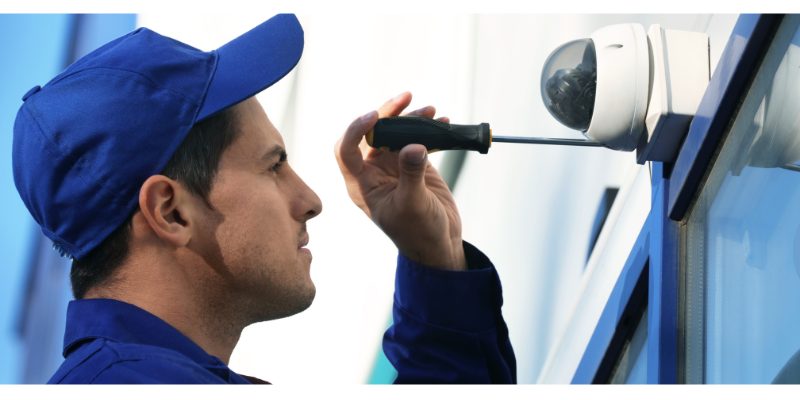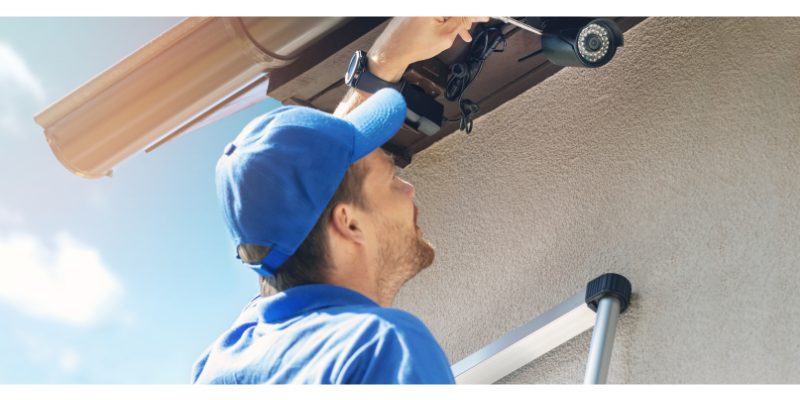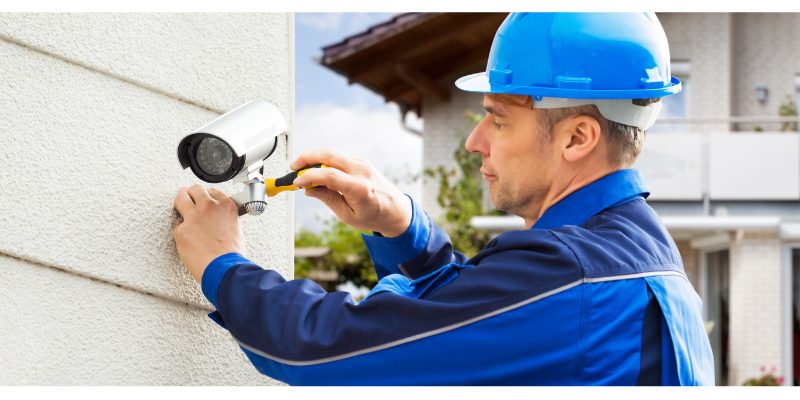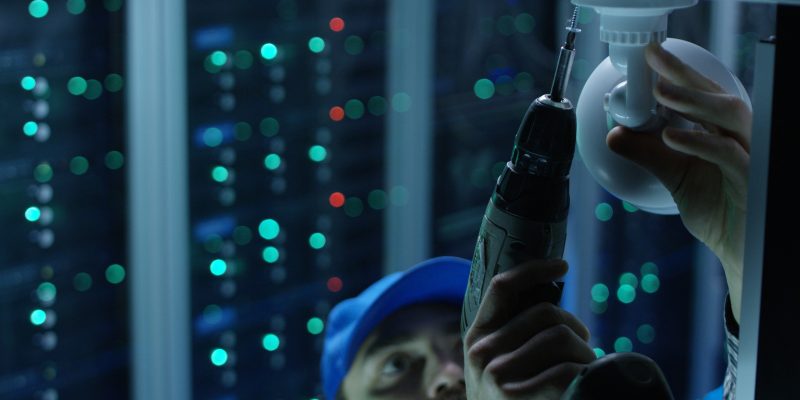Table of Contents
ToggleSecurity cameras installation is a crucial step in safeguarding your home and business from potential threats.
Whether you’re looking to protect your family, employees, or assets, having a reliable security system in place can provide peace of mind and deter criminal activity.
In this blog post, we’ll explore the ins and outs of security cameras installation, from understanding the basics to evaluating your security needs, exploring different types of cameras, and discussing the installation process.
By the end of this post, you’ll have a better understanding of how to enhance your security through vigilance and technology.
Understanding the Basics of Security Cameras Installation
Delving into the realm of security cameras installation is the first step towards fortifying your home or business.
At its core, this process begins with grasping the diverse array of cameras available—each tailored to meet specific surveillance needs.
Dome cameras, noted for their discreet appearance, blend seamlessly into any environment, making them ideal for public areas where aesthetics are a concern.

Bullet security cameras, recognizable by their elongated shape, offer focused coverage, making them perfect for viewing long distances.
PTZ (Pan, Tilt, Zoom) cameras, meanwhile, provide a dynamic surveillance option, allowing operators to remotely control their field of view—panning, tilting, and zooming to capture the details that matter most.
Choosing the right camera extends beyond just form and function; it’s about understanding the specifications that matter.
Resolution and field of view are critical—higher resolutions offer clearer images, while a wider field of view covers more area, reducing the number of cameras needed.
Night vision capabilities are also paramount, ensuring round-the-clock security.
By navigating these basics, you position yourself to make educated decisions, laying a solid foundation for a security system that aligns with your specific requirements.
Security Cameras Installation: Evaluate Your Needs
Assessing your security requirements and objectives is a step of paramount importance, one that demands careful thought and a strategic approach.
The dimensions of the area you wish to monitor, coupled with the degree of surveillance necessary, must be factored into your security camera installation plan.
In addition, it’s essential to reflect on the particular threats or vulnerabilities that your home or business might be exposed to.
Are you more concerned about external threats such as break-ins, or is internal surveillance, such as monitoring employee activity, a priority?
The answers to these questions will not only influence the type and number of cameras needed but also the specific features that will be most beneficial to your setup.
This process is not about adopting a one-size-fits-all approach but rather about customizing your security camera system to align with your specific needs.
By diligently evaluating these aspects, you can design a tailored solution that not only meets but surpasses your security expectations, ensuring that your assets are protected in the most efficient and effective way possible.
Exploring Types of Security Cameras and Their Features
Venturing into the realm of security camera installation, unveils a plethora of options, each equipped with distinct features that cater to diverse surveillance needs.
The journey begins with understanding the spectrum ranging from the robustness of wired cameras to the flexibility of wireless models.
As well as navigating through the intricacies of indoor versus outdoor setups, and delving into the advanced realms of versus IP cameras.
Wired cameras stand out for their reliability, ensuring a continuous power supply and a stable connection, crucial for areas demanding uninterrupted surveillance.
Wireless cameras, on the other hand, champion ease of installation and adaptability, allowing for strategic placements without the constraints of wiring.
Indoor cameras are designed with discretion in mind, blending seamlessly with interiors, while outdoor cameras are built to withstand the elements, ensuring durability against weather adversities.
The transition from analog to IP cameras marks a significant leap in surveillance technology. Analog cameras, traditional in their approach, offer simplicity and affordability.
IP cameras elevate the surveillance experience, delivering superior image quality, scalability, and the flexibility of remote access, transforming the way we monitor our sanctuaries.

Each security camera type comes equipped with features such as motion detection, which triggers recording upon sensing activity, and two-way audio, facilitating communication with visitors or intruders.
Cloud storage emerges as a game-changer, providing remote access to footage, ensuring that critical moments are captured and stored securely, accessible from anywhere, anytime.
This exploration into the types of security cameras and their features is a testament to the advancements in technology.
It empowers individuals and businesses to tailor their surveillance systems to meet specific security objectives, ensuring protection and peace of mind in an ever-evolving world.
The Security Cameras Installation Process: Steps and Best Practices
Embarking on the security cameras installation journey requires a blend of technical know-how and strategic planning.
The process commences with pinpointing the optimal locations for your CCTV cameras.
Do a careful assessment of your property to identify areas of vulnerability and high foot traffic, ensuring comprehensive coverage without blind spots.
Equally important is the consideration of height and angle to maximize field of view and minimize tampering or obstruction.
Once the ideal spots are determined, the next step involves the meticulous mounting of your cameras, a task that demands precision and attention to detail.
For those opting for wired systems, cable management is key to not only maintaining an uncluttered appearance but also to protecting the wires from environmental damage or intentional tampering.
Wireless security camera systems, while freeing you from the complexities of wiring, still require a stable and strong Wi-Fi connection to function flawlessly.
Configuring your system is the next crucial phase, involving the setup of the DVR or NVR, along with any necessary software and applications for remote access.
This step transforms your physical installation into a fully operational surveillance system.
Engaging with professional services can also provide invaluable insights and assistance, particularly for complex setups or when customization is needed to meet specific surveillance objectives.
Wired vs. Wireless Systems: Choose What’s Best for You
In the landscape of security camera installations, the decision between wired and wireless systems is pivotal, each pathway offering its distinct advantages tailored to diverse scenarios and preferences.
Wired systems, renowned for their steadfast reliability, anchor your security network with a direct, uninterrupted power and data transmission, ensuring a constant vigil over your premises.
This pathway is particularly beneficial in settings where stability is non-negotiable, offering a bulwark against the vulnerabilities often exploited in wireless networks.
The allure of wireless surveillance systems lies in their unparalleled flexibility and the ease with which they can be integrated into environments where physical wiring proves challenging or aesthetically displeasing.
These systems thrive on convenience, facilitating swift adjustments and relocations of cameras to adapt to evolving surveillance needs without the constraints of cabling.
The operational essence of wireless systems is their ability to mesh seamlessly with dynamic, modern lifestyles, providing a streamlined approach to security that caters to the rapid pace of change.
The decision matrix between wired and wireless security camera systems extends beyond mere preference, delving into the specifics of your surveillance needs, the architecture of your space, and the extent of coverage desired.
It beckons a thoughtful consideration of your unique circumstances, inviting a bespoke solution that aligns with your vision of security and tranquility.
Legal Considerations and Privacy Laws
Navigating the terrain of legal considerations and privacy laws is an indispensable aspect of installing security cameras.
This process mandates an acute awareness of the legal landscape surrounding surveillance.
Crucially, adherence to local and federal laws ensures that your security efforts remain within the bounds of legality.
This includes familiarizing oneself with regulations that may dictate the necessity of signage indicating the presence of surveillance equipment.
Equally important are the restrictions against recording in spaces where individuals have a reasonable expectation of privacy, such as restrooms and changing areas.
The integrity of your security camera system is deeply intertwined with respecting the privacy rights of others.
For instance, deploying surveillance cameras in a manner that exclusively monitors your property and public areas, while avoiding encroachment into private spaces of neighbors, is a practice founded on ethical surveillance.
Additionally, the manner in which recorded data is stored and accessed is governed by privacy laws, emphasizing the need for secure storage solutions and controlled access protocols.
Engaging in a comprehensive review of these legal frameworks prior to installation not only fortifies your security strategy against potential legal challenges but also fosters a culture of respect and privacy.
This balance between vigilance and adherence to privacy laws is the cornerstone of a trustworthy and effective security camera system.
Incorporating Smart Technology and Remote Access
The realm of security is being revolutionized with the integration of smart technology and remote access capabilities, catapulting traditional surveillance into the digital age.
Embracing these advancements allows for a transformative approach to monitoring, where convenience meets efficiency.

Picture the empowerment of receiving real-time motion alerts, the flexibility of watching live feeds from any corner of the globe, and the assurance of having your property’s footage securely stored in the cloud.
These features are not mere luxuries but essential components that adapt your security system to fit the modern lifestyle.
Enabling remote access through smart devices ensures that you’re always connected to what matters most, providing a layer of control and peace of mind previously unattainable.
As we navigate the complexities of today’s security needs, incorporating smart technology into our surveillance strategies isn’t just an option; it’s a pivotal step towards a more secure and accessible future.
Maintenance and Upkeep: Ensuring Long-Term Effectiveness
Whether is a home surveillance system or Commercial CCTV, The vitality of your security cameras hinges not just on the initial installation but on a continuous commitment to maintenance and upkeep.
Regular checks and cleaning of the lenses ensure the clearest vision, safeguarding the quality of footage captured.
Periodic inspections to identify any wear or environmental damage can preempt failures, maintaining the resilience of your system against the elements or tampering.
Equally crucial is the software aspect—keeping firmware and applications up to date shields your system from vulnerabilities and optimizes performance.
This proactive approach not only extends the lifespan of your equipment but also ensures that your security system remains effective and reliable, ready to meet the demands of safeguarding your premises.
Embrace these maintenance practices as part of your routine, reinforcing the security foundation you’ve diligently built.
Overcoming Common Challenges in Security Cameras Installation
Navigating through the installation of surveillance cameras ( unlike the installation of Home Theater Systems ) often presents hurdles that, while initially daunting, can be adeptly managed with strategic planning and resourcefulness.
Connectivity issues, a common impediment, can frequently be mitigated through ensuring a robust wireless network or opting for a wired setup in areas where signal strength is a concern.
The dilemma of optimal camera placement is another challenge, where the art of surveillance meets the science of security.
Strategic positioning, informed by a thorough assessment of your property’s layout and potential vulnerabilities, ensures comprehensive coverage.
Additionally, addressing the challenge of an insufficient power supply involves thoughtful planning regarding the placement of cameras in proximity to power sources or the utilization of power extension solutions.
Embracing these challenges as opportunities for thoughtful problem-solving will lead to a more secure and resilient installation, enhancing the overall effectiveness of your security system.
Final Thoughts: Enhancing Security Through Vigilance and Technology
In wrapping up our journey through the landscape of security cameras installation, it’s evident that the fusion of vigilance and advanced technology is the keystone in fortifying the safety of our domains.
This exploration has unveiled the criticality of a well-thought-out approach, from choosing the suitable type of camera to understanding the nuances of CCTV installation and the importance of ongoing maintenance.
Embracing this pathway, characterized by continuous learning and adaptation to emerging technologies, positions us at the vanguard of protecting our homes and businesses.
The empowerment derived from a meticulously crafted security camera system—complemented by the sophistication of smart technology and remote access—transcends mere surveillance; it embodies a proactive stance against potential threats.
As we navigate the complexities of ensuring safety in a dynamic world, let this be a testament to the power of integrating vigilance with cutting-edge technology to secure our sanctuaries and the people within them.

